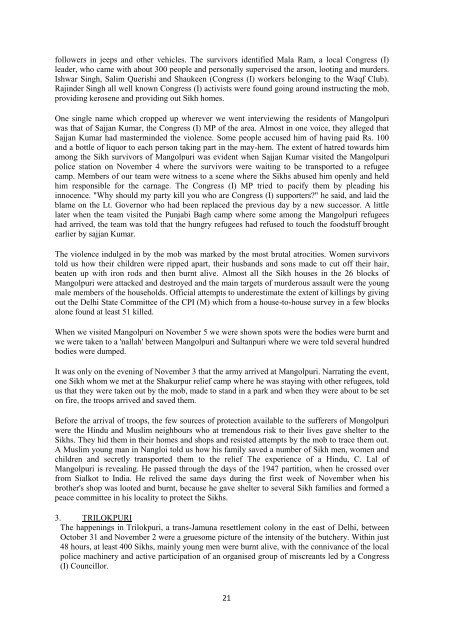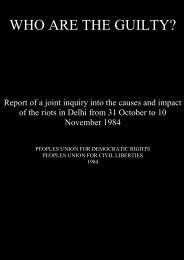Who are the Guilty(1)
Who are the Guilty(1)
Who are the Guilty(1)
Create successful ePaper yourself
Turn your PDF publications into a flip-book with our unique Google optimized e-Paper software.
followers in jeeps and o<strong>the</strong>r vehicles. The survivors identified Mala Ram, a local Congress (I)<br />
leader, who came with about 300 people and personally supervised <strong>the</strong> arson, looting and murders.<br />
Ishwar Singh, Salim Querishi and Shaukeen (Congress (I) workers belonging to <strong>the</strong> Waqf Club).<br />
Rajinder Singh all well known Congress (I) activists were found going around instructing <strong>the</strong> mob,<br />
providing kerosene and providing out Sikh homes.<br />
One single name which cropped up wherever we went interviewing <strong>the</strong> residents of Mangolpuri<br />
was that of Sajjan Kumar, <strong>the</strong> Congress (I) MP of <strong>the</strong> <strong>are</strong>a. Almost in one voice, <strong>the</strong>y alleged that<br />
Sajjan Kumar had masterminded <strong>the</strong> violence. Some people accused him of having paid Rs. 100<br />
and a bottle of liquor to each person taking part in <strong>the</strong> may-hem. The extent of hatred towards him<br />
among <strong>the</strong> Sikh survivors of Mangolpuri was evident when Sajjan Kumar visited <strong>the</strong> Mangolpuri<br />
police station on November 4 where <strong>the</strong> survivors were waiting to be transported to a refugee<br />
camp. Members of our team were witness to a scene where <strong>the</strong> Sikhs abused him openly and held<br />
him responsible for <strong>the</strong> carnage. The Congress (I) MP tried to pacify <strong>the</strong>m by pleading his<br />
innocence. "Why should my party kill you who <strong>are</strong> Congress (I) supporters?" he said, and laid <strong>the</strong><br />
blame on <strong>the</strong> Lt. Governor who had been replaced <strong>the</strong> previous day by a new successor. A little<br />
later when <strong>the</strong> team visited <strong>the</strong> Punjabi Bagh camp where some among <strong>the</strong> Mangolpuri refugees<br />
had arrived, <strong>the</strong> team was told that <strong>the</strong> hungry refugees had refused to touch <strong>the</strong> foodstuff brought<br />
earlier by sajjan Kumar.<br />
The violence indulged in by <strong>the</strong> mob was marked by <strong>the</strong> most brutal atrocities. Women survivors<br />
told us how <strong>the</strong>ir children were ripped apart, <strong>the</strong>ir husbands and sons made to cut off <strong>the</strong>ir hair,<br />
beaten up with iron rods and <strong>the</strong>n burnt alive. Almost all <strong>the</strong> Sikh houses in <strong>the</strong> 26 blocks of<br />
Mangolpuri were attacked and destroyed and <strong>the</strong> main targets of murderous assault were <strong>the</strong> young<br />
male members of <strong>the</strong> households. Official attempts to underestimate <strong>the</strong> extent of killings by giving<br />
out <strong>the</strong> Delhi State Committee of <strong>the</strong> CPI (M) which from a house-to-house survey in a few blocks<br />
alone found at least 51 killed.<br />
When we visited Mangolpuri on November 5 we were shown spots were <strong>the</strong> bodies were burnt and<br />
we were taken to a 'nallah' between Mangolpuri and Sultanpuri where we were told several hundred<br />
bodies were dumped.<br />
It was only on <strong>the</strong> evening of November 3 that <strong>the</strong> army arrived at Mangolpuri. Narrating <strong>the</strong> event,<br />
one Sikh whom we met at <strong>the</strong> Shakurpur relief camp where he was staying with o<strong>the</strong>r refugees, told<br />
us that <strong>the</strong>y were taken out by <strong>the</strong> mob, made to stand in a park and when <strong>the</strong>y were about to be set<br />
on fire, <strong>the</strong> troops arrived and saved <strong>the</strong>m.<br />
Before <strong>the</strong> arrival of troops, <strong>the</strong> few sources of protection available to <strong>the</strong> sufferers of Mongolpuri<br />
were <strong>the</strong> Hindu and Muslim neighbours who at tremendous risk to <strong>the</strong>ir lives gave shelter to <strong>the</strong><br />
Sikhs. They hid <strong>the</strong>m in <strong>the</strong>ir homes and shops and resisted attempts by <strong>the</strong> mob to trace <strong>the</strong>m out.<br />
A Muslim young man in Nangloi told us how his family saved a number of Sikh men, women and<br />
children and secretly transported <strong>the</strong>m to <strong>the</strong> relief The experience of a Hindu, C. Lal of<br />
Mangolpuri is revealing. He passed through <strong>the</strong> days of <strong>the</strong> 1947 partition, when he crossed over<br />
from Sialkot to India. He relived <strong>the</strong> same days during <strong>the</strong> first week of November when his<br />
bro<strong>the</strong>r's shop was looted and burnt, because he gave shelter to several Sikh families and formed a<br />
peace committee in his locality to protect <strong>the</strong> Sikhs.<br />
3. TRILOKPURI<br />
The happenings in Trilokpuri, a trans-Jamuna resettlement colony in <strong>the</strong> east of Delhi, between<br />
October 31 and November 2 were a gruesome picture of <strong>the</strong> intensity of <strong>the</strong> butchery. Within just<br />
48 hours, at least 400 Sikhs, mainly young men were burnt alive, with <strong>the</strong> connivance of <strong>the</strong> local<br />
police machinery and active participation of an organised group of miscreants led by a Congress<br />
(I) Councillor.<br />
21



